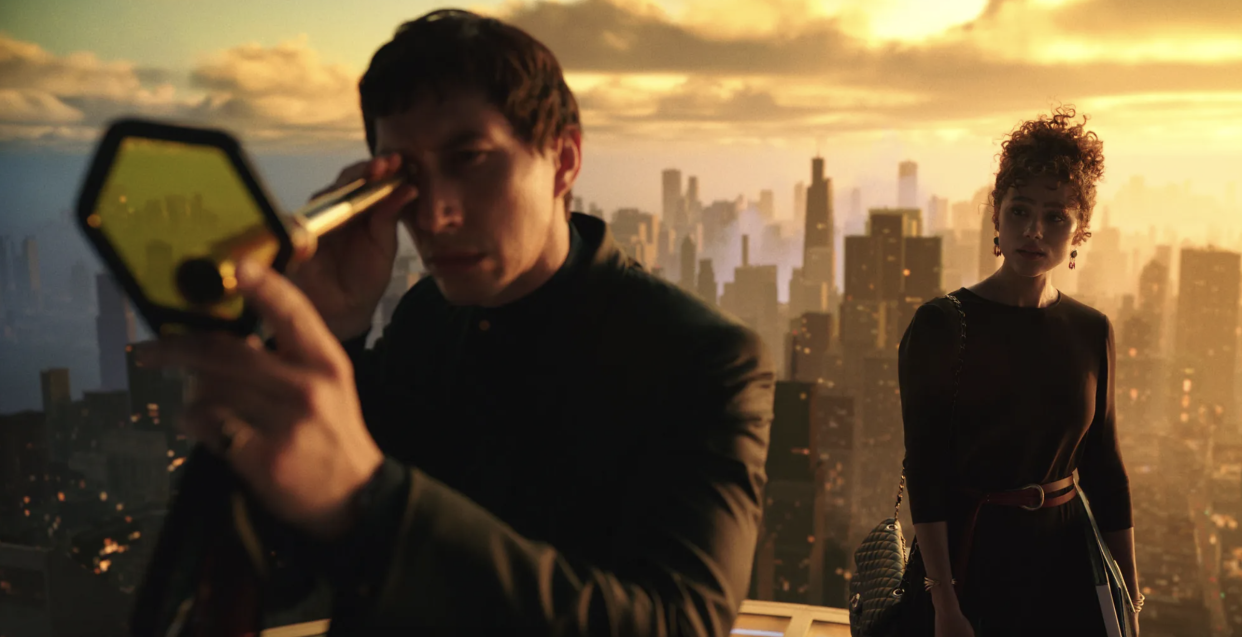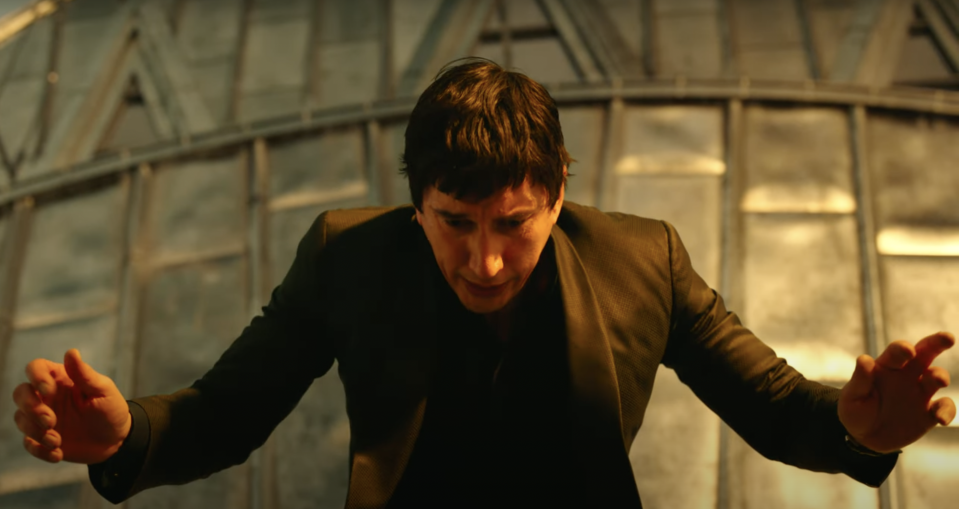‘Megalopolis’ Review: Francis Ford Coppola’s Wild and Delirious Fever Dream Inspires New Hope for the Future of Movies


As personal and egoless as you could ever hope to expect from an $120 million self-portrait that doubles as a fable about the fall of Ancient Rome, Francis Ford Coppola’s “Megalopolis” is the story of an ingenious eccentric who dares to stake his fortune on a more optimistic vision for the future — not because he thinks he can single-handedly bring that vision to bear, but rather because history has taught him that questioning a civilization’s present condition is the only reliable hope for preventing its ruin. Needless to say, the movie isn’t arriving a minute too soon.
After more than 40 years of idly fantasizing about the project (and more than 20 years of actively trying to finance it), Coppola is bringing “Megalopolis” to screens at a moment when his chosen medium is struggling to find a way forward, and the world around it seems teetering on the brink of collapse. Just as in 63 B.C., when an evil patrician named Catiline appealed to a coalition of malcontents in a bid to overthrow the Republic, we are choked by the grip of delusional aristocrats and vertically integrated conglomerates whose lust for power and profit is only matched by their lack of foresight. Even with the past as our guide, we are at imminent risk of allowing the now to destroy the forever.
More from IndieWire
Coppola has always believed in America, but his faith is eroding by the second, and “Megalopolis” is nothing if not the boldest and most open-hearted of his many bids to stop time before it’s too late (an effort that has informed so much of his career, from “Peggy Sue Got Married” and “Bram Stoker’s Dracula” to “Youth After Youth” and “Jack”). As ever, he recognizes the futility in the attempt, even if his characters are sometimes a bit slow on the uptake.
What elevates “Megalopolis” so far above those other films — even “Jack” — is how clearly the constant madness of its folly and the occasional disaster of its design serve as conduits for its writer/director/producer/financier’s entire creative ethos. Coppola might lack the imagination required to invent the new cinema that his new movie so desperately wishes it could will into being (he’s not even De Palma in that respect, let alone Godard), but he’s always seen the need for it better and more urgently than any of his contemporaries.
With “Megalopolis,” he crams 85 years worth of artistic reverence and romantic love into a clunky, garish, and transcendently sincere manifesto about the role of an artist at the end of an empire. It doesn’t just speak to Coppola’s philosophy, it embodies it to its bones. To quote one of the sharper non-sequiturs from a script that’s swimming in them: “When we leap into the unknown, we prove that we are free.”
“Megalopolis” naturally begins with its hero — Coppola’s young, Adam Driver-shaped avatar — struggling to put his trust in that promise. His name is Cesar Catalina, he’s essentially a dark and jittery hodgepodge of Steve Jobs and Robert Moses, and he almost steps off the roof of the Chrysler Building before he’s saved by his ability to stop time with a snap of his fingers. A modern and more altruistic variation on the ancient Cataline, this Cesar dreams of constructing a utopian “city-school” atop the ruins of New Rome, but this swaggy power broker seems to be suffering from a lack of faith that he’ll be able to see it through (character development never goes deeper than is conceptually required by Coppola’s script, and even by the end of the movie, it’s hard to pinpoint much trace of reason or human emotion in Cesar or anyone else).
Like Cesar, it might be for the best if we take a step back. Let’s start with New Rome, which is pretty much just downtown Atlanta cosplaying as a modern-day Manhattan that’s been artificially saturated with a vanilla skyline and set-dressed to resemble a Joel Schumacher Batman movie (complete with the same faux-debauched energy, and a host of glaring digital flourishes that also locate “Megalopolis” somewhere in the vicinity of Vera Drew’s “The People’s Joker,” the only other movie so far this year that can match the go-for-broke visual exuberance on display here).
Coppola — and the special effects team that his nephew Jesse James Chisholm was hired to assemble after the director fired his original VFX supervisor — try to complete the illusion with a variety of composite wide shots that highlight the scale of the city, but the fact that Times Square restaurant Ruby Foo’s survived the leap to New Rome should give you an accurate impression of how far this fable strays from geographical reality: not very. In other news, Madison Square Garden has naturally been reimagined as a sandy colosseum. The exterior shots don’t look anything like the world-famous arena they’re meant to represent, but the interior ones get MSG’s iconic ceiling exactly right. At least the inconsistency helps keep you on your toes.
Cesar’s great hope for the future of this hodgepodge city is a new element he invented called Megalon, which glows yellow, does whatever is most convenient for the scene at hand, and may or may not have played a role in the tragic death of his wife. “Megalopolis” is of course dedicated to Coppola’s late wife Eleanor, who died after the completion of the film, but whose loving memory nevertheless casts a long shadow over this story about a self-involved iconoclast whose mind is always obsessively preoccupied with his work.
The DA who prosecuted the city’s failed homicide case against Cesar is now the mayor of New Rome, and our hero’s rival in the bid to control the megalopolis’ levers of power; his name is Franklyn Cicero (natch), he’s played by a game and jowly Giancarlo Esposito, and his beautiful daughter Julia will soon become Cesar’s closest advisor and most intimate muse (credit to Nathalie Emmanuel, doing her best with a wooden character in a film that reduces all of its women to cartoons in the face of male genius). Cesar envisions a New Rome that “people can dream about,” while Cicero hopes to build “a fun casino” with more practical dividends.
This being a nine-figure movie that flows with the ramshackle energy of a Wooster Group production, the two titans naturally debate their visions on a wooden catwalk above a scale model of the city, with Cesar launching into Hamlet’s “To Be or Not to Be” speech while the likes of Dustin Hoffman, James Remar, and “SNL” star Chloe Fineman stand in the background looking confused. Coppola instructed Driver to give that monologue on a whim, and then decided to include it in place of the dialogue that he’d written for the scene; even after writing 300 drafts and spending a fortune of his own money, he was still willing to throw everything out and free-associate with his famous cast at a moment’s notice.
That sort of creatively unbound approach may not have resulted in a surplus of dramatically coherent scenes, but it undergirds the entire movie with a looseness that makes it almost impossible to look away. You never know when Grace VanderWaal might split into five identical clones of herself while singing an original pop anthem about her virginity, or when Laurence Fishburne — back for more of the fun he had with Coppola on the set of “Apocalypse Now” — might invoke some more wisdom via his voiceover narration, or when Aubrey Plaza’s gold-digging seductress/news anchor might shift her overt sexual attention to a different member of New Rome’s ruling class. Her character’s name is Wow Platinum, because every generation gets the “Southland Tales” it deserves. First she’s hot for Cesar, then for his gazillionaire banker uncle Hamilton Crassus III (Jon Voight), and finally for Crassus’ sociopathic court jester of a son, Clodio Pulcher (a palpably malevolent Shia LaBeouf).
Things proceed to happen in the general shape of a Shakespeare play, some of them more memorable than others. The plot is perfectly clear in broad strokes (“Megalopolis” bills itself as a fable, and adheres to the narrative simplicity and high-key moralizing required by that format), but making sense of the movie still requires your brain to course-correct for subversion, the way it does when you read a sentence whare evry werd iis slightely mispeld. I’m still not sure what the deal is with the Russian satellite that threatens to crash into the city, but it makes an impact all the same.
The story is sustained by the sheer force of Coppola’s enthusiasm for it, and it hardly seems to matter that each scene feeds into the next with the grace of a wave crashing into a jetty — not when it’s so exciting to see what might happen next, and stray moments of transcendent surprise can be found hiding in even the flattest stretches. Two people connected by an invisible rope as they run through a hallway. A fallen rose suspended in mid-air. A rain-slicked noir chase sequence melting into a vision of eternal devotion.

The screwball comedy of it all is the only element that consistently lands with a thud, but perhaps that’s because Coppola’s love for Ernst Lubitsch doesn’t run as deep as his love for Alfred Hitchcock. Or Ralph Waldo Emerson. Or “Utopia” philosopher Thomas More. Or the Archaic Greek poet Sappho, or architect William Van Alen, or any of the countless other great thinkers who’ve found their way into this hyper-vivid index of Coppola’s most deeply cherished influences, all of them mulched together into a single film that draws upon their genius in order to stave off the cynicism and despair of the status quo that’s used to comfort us as we hurdle towards a cliff. To paraphrase what someone once said to Marcus Aurelius in an Anthony Mann movie: When does an empire die? Not in a terrible moment, but when people no longer believe in it.
So while it might be tempting to see this kooky, nepotistically cloistered, and unconscionably expensive magnum opus as the self-involved work of a fading artist who’s lost whatever was left of his ability to tell good ideas from bad, “Megalopolis” does everything in its power to remind the audience that we share in the outcome of its demented fever dream. Which isn’t to say that we’re obligated to make this particular movie a success, only that we’d do well to examine the source of whatever hostility it might reflexively produce within us. Why does change scare us so much that we’d sooner forfeit our freedom to imagine a better world than reckon with the possibilities such freedom allows? Quoth Marcus Aurelius again: “The universe is change; our life is what our thoughts make of it.”
And “Megalopolis” — in its most dazzling and audacious moment — breaks through the screen to bridge the gap between life and thought, art and reality. It’s a moment that may only exist at Cannes, in much the same way as Coppola’s dream of live-remixing “Twixt” during a nationwide roadshow failed to survive beyond his panel at Comic-Con, but the impossibility of replicating it tomorrow is no excuse not to celebrate it today. Like so much of this movie, the scene in question doesn’t show us the future of cinema so much as it galvanizes our desire to ensure that it has one.
“I will not let time have dominion over my thoughts,” Cesar repeats to himself as a compulsive mantra. “Artists can never lose their control of time,” Julia tells him. “Painters freeze it, poets sing of it, musicians rhythmatize it…,” she trails off. What do filmmakers do? They stop it to remind us that we can’t. With the profoundly moving final shot of “Megalopolis,” Coppola insists that’s all the more reason to fight for the future.
Grade: B+
“Megalopolis” premiered in Competition at the 2024 Cannes Film Festival. It is currently seeking U.S. distribution.
Best of IndieWire
Sign up for Indiewire's Newsletter. For the latest news, follow us on Facebook, Twitter, and Instagram.

 Yahoo Movies
Yahoo Movies 
